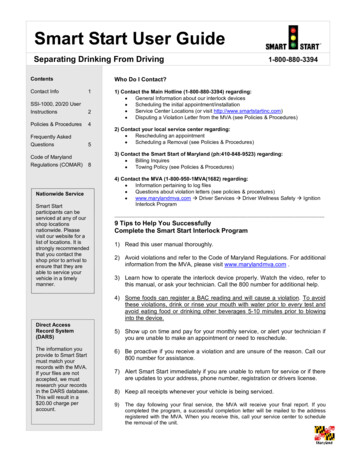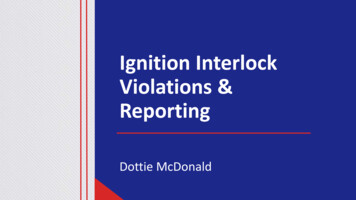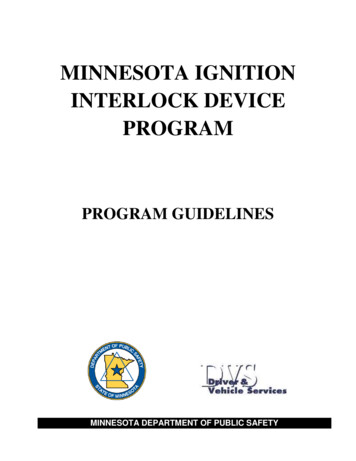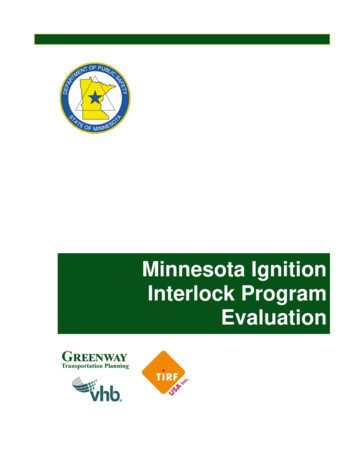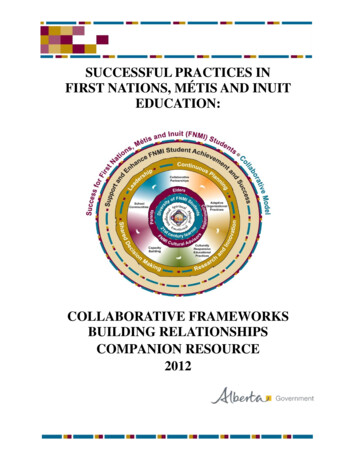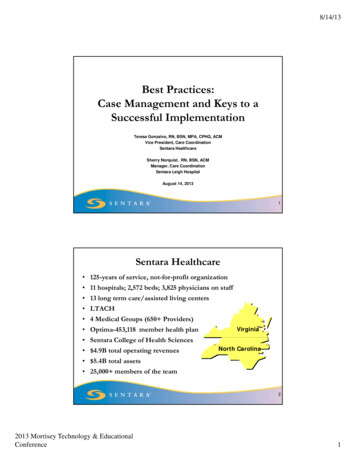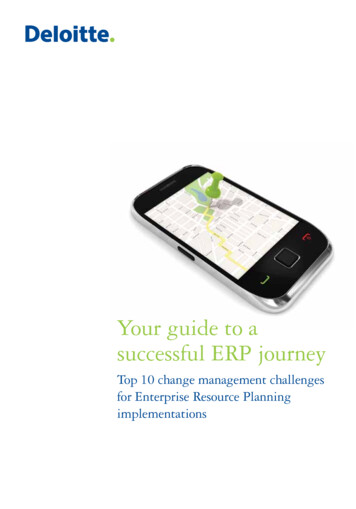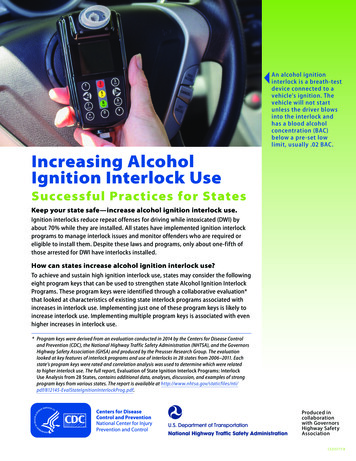
Transcription
An alcohol ignitioninterlock is a breath-testdevice connected to avehicle’s ignition. Thevehicle will not startunless the driver blowsinto the interlock andhas a blood alcoholconcentration (BAC)below a pre-set lowlimit, usually .02 BAC.Increasing AlcoholIgnition Interlock UseSuccessful Practices for StatesKeep your state safe—increase alcohol ignition interlock use.Ignition interlocks reduce repeat offenses for driving while intoxicated (DWI) byabout 70% while they are installed. All states have implemented ignition interlockprograms to manage interlock issues and monitor offenders who are required oreligible to install them. Despite these laws and programs, only about one-fifth ofthose arrested for DWI have interlocks installed.How can states increase alcohol ignition interlock use?To achieve and sustain high ignition interlock use, states may consider the followingeight program keys that can be used to strengthen state Alcohol Ignition InterlockPrograms. These program keys were identified through a collaborative evaluation*that looked at characteristics of existing state interlock programs associated withincreases in interlock use. Implementing just one of these program keys is likely toincrease interlock use. Implementing multiple program keys is associated with evenhigher increases in interlock use.* Program keys were derived from an evaluation conducted in 2014 by the Centers for Disease Controland Prevention (CDC), the National Highway Traffic Safety Administration (NHTSA), and the GovernorsHighway Safety Association (GHSA) and produced by the Preusser Research Group. The evaluationlooked at key features of interlock programs and use of interlocks in 28 states from 2006–2011. Eachstate’s program keys were rated and correlation analysis was used to determine which were relatedto higher interlock use. The full report, Evaluation of State Ignition Interlock Programs: InterlockUse Analysis from 28 States, contains additional data, analyses, discussion, and examples of strongprogram keys from various states. The report is available at alStateIgnitionInterlockProg.pdf.Produced incollaborationwith GovernorsHighway SafetyAssociationCS255777-B
I N C R E A S I N G ALCO H O L I G N I T I O N I N T E R LO C K U S EEight Program Keys for Strong State Alcohol Ignition Interlock ProgramsPROGRAM KEY2CHARACTERISTICS OF ASTRONG PROGRAM KEYEXAMPLERequire orincentivize useRequirement or strong incentiveto install interlocksA law covering all offenders withsignificant reduction of hard licensesuspension period if interlock is installedLevy strong penaltiesStrong, swift, and appropriate penaltiesExtension of interlock time, homemonitoring, fail breath test, or tamperor otherwise circumvent interlockMonitor interlocksto ensure proper useCareful monitoring to assure interlocksare installed and used as intendedRandom checks by DMV, probation, ortreatment centers to ensure offender hasinstalled and is using an interlockImplement uniformlyacross stateUniform and consistent implementation,statewideAll agencies report data regularly incompatible format, using uniformdefinitions of violationsin same time frameCoordinateacross agenciesClose coordination and communicationacross all agenciesRegular communication withrepresentatives from all interlockprogram involved agenciesEducate stakeholdersabout the programRegular training or education for allinterlock agency staff and managementRegular trainings between interlockprogram managers, law enforcement,vendors, DMV, and court staffProvide adequateresourcesAdequate staff and funding resourcesDesignated interlock program managerand staff, financial assistance foroffendersUse data for actionExcellent data records (including levelof offense, BAC level at time of arrest,number of prior arrests, installation/removal dates, violations)Combined annual data on offendersavailable from all agencies to monitoroffenders, report violators and evaluateprogram effectiveness
A. Program DesignProgram Key #1: Require or incentivize useRequirements are determined by state ignition interlock laws and describewhich types of offenders (first-time, repeat, or high BAC*) are required to installinterlocks. State laws may also define incentives for installing an interlock.*Usually defined as BAC 0.15 mg/dl which varies by state.States in Action:Number of Interlocks in UseInterlocks in Use After Requirements Were Implemented12,000STRONGRequirements arestrongly associatedwith increasedinterlock 02,5002,0001,7041,1950New 010)Arkansas(2009/2010)StateYear requirement was implementedYear after requirement was implemented New York: Required interlocks for first time offenders, interlock use increased 100% in thefollowing year. Wisconsin: Required interlocks for repeat or high-BAC offenders, interlock use increased555% in the following year. Illinois: Required interlocks to obtain hardship license, interlock use increased 69% in thefollowing year. Arkansas: Required interlocks to reduce or eliminate license suspension period, interlockuse increased 245% in the following year.3
I N C R E A S I N G ALCO H O L I G N I T I O N I N T E R LO C K U S EProgram Key #2: Levy strong penaltiesPenalties, determined by state ignition interlock use laws, are for offenders’failure to install an interlock, failing a breath test, missing a breath test, or actionto bypass the installed device by driving a different vehicle. For penalties to beeffective, they should be swift, certain, and appropriately severe.1 In other words,a penalty should be less attractive to the offender than installing the interlockand should serve the same purpose as the interlock in keeping the offender fromdriving impaired.M O D E R AT EPenalties aremoderately associatedwith increasedinterlock use.States in Action:Driver’s license suspension as a penalty for failing to install an interlock by AAKFLLegendHISuspends licenseDoes not suspend licenseNot included in the study Washington: Applies a four month extension of the original interlock restriction period foroffenders who violate program requirements before license reinstatement can occur. Wisconsin: Applies a six month extension of the original interlock restriction period beforelicense reinstatement can occur. Maryland: Implements criminal sanctions such as home monitoring or jail if an individual withan interlock requirement on his/her license is caught operating a vehicle that is not equippedwith an ignition interlock.14Dula CS.Dwyer WO, LeVerne, G. (2007) Policing the drunk driver: Measuring law enforcement involvement in reducingalcohol-impaired driving. Journal of Safety Research 38:267–272.
B. Program ManagementProgram Key #3: Monitor interlocks to ensure proper useMonitoring describes ways in which the program follows-up with offenders tomake sure they have installed the device correctly, are driving the vehicle with theinstalled device, and not failing or missing tests or circumventing the interlock.States in Action: Colorado: Accesses the Online Interlock System (OIS), which uses vendorSTRONGMonitoring is stronglyassociated withincreased interlock use.data to electronically produce an installation certificate and sets the interlockrequirement duration and end-date. OIS data are monitored by the Departmentof Motor Vehicle (DMV) driver control unit. Virginia: Monitors the ignition interlock program through the Virginia Alcohol Safety ActionProgram (VASAP). Courts usually issue Restrictive Driver’s License Order forms requiring DWIoffenders to attend VASAP education programs and install an interlock. The VASAP case managerthen monitors the offender’s interlock activities. Washington: Expanded its data reporting and tracking system in 2010. In order to restore theirdriving privileges, offenders required to install interlocks must install them, complete therequired time period, and complete the final four months without violations, as certified by theinterlock vendors.Program Key #4: Implement uniformly across stateUniformity refers to consistent operations for program requirements,enforcement, and administration across the state. Consistent documentation ofoffenses and uniform reporting among state agencies increases overall programefficiency and provides the ability to monitor offenders accurately. Uniformcertification procedures for vendors and interlocks, certified installation centers,and uniform reporting procedures also increase efficiency.M O D E R AT EUniformity ismoderately associatedwith increasedinterlock use.When programs are strictly judicial, they typically are not uniform becauseindividual judges decide on interlock requirements, monitoring, and violation consequences. When thestate’s interlock program is administrative (through the DMV, for example) or a hybrid of administrativeand judicial, they usually are uniform statewide because there is just one statewide implementation planthat is upheld by the courts for all offenders.States in Action: Washington: The state patrol has full authority over monitoring in-the-field compliance with theinterlock program. Unified reporting was also implemented in the state.5
I N C R E A S I N G ALCO H O L I G N I T I O N I N T E R LO C K U S EProgram Key #5: Coordinate across agenciesThe coordinated efforts of many stakeholders are necessary for effective stateignition interlock programs. Typical stakeholders include law enforcement,prosecutors, judges, probation, licensing, alcohol treatment, and interlock vendors.States in Action: Several states, including Colorado, Oregon, and Texas hold regularconferences or meetings between agencies to discuss impaired drivingmatters, including ignition interlocks.M O D E R AT ECoordination ismoderately associatedwith increasedinterlock use. Colorado: Implemented a Persistent Drunk Driver Committee where representatives from theDivision of Behavioral Health, Probation Services, and DMV meet regularly to provide continualprogram assessment, education, and training on interlocks and interlock programs.Program Key #6: Educate stakeholders about the programEducation refers to all of the necessary trainings on ignition interlocks andassociated programs and procedures. The audiences for the trainings includeall ignition interlock stakeholders, from offenders to state agencies thatadminister the program.States in Action: Arizona: Included ignition interlocks as a topic at their annual judges’M O D E R AT EEducation ismoderately associatedwith increasedinterlock use.conference. Texas: Used their Center for the Judiciary to educate judges and court staff on using interlocksas a tool to reduce repeat DWI offenders.6
C. Program SupportProgram Key #7: Provide adequate resourcesResources refer to adequate staff and funding. In addition, resources can providefinancial assistance for offenders to install interlocks. Therefore, while resourceswere not directly associated with higher interlock use, they are critical to supportthe other program keys.States in Action: Colorado: Created a financial assistance program for low-income offendersfunded by license offenders’ reinstatement fees.WEAKResources alone areweakly associated withincreased interlock use,though they are vitalto support the otherprogram keys. North Carolina: Uses 50% of the DWI offender fees to assist offenders withinstallation and removal of interlocks. Missouri: An administrative portion was added to the interlock program that began as ajudicial program. Oregon: Uses the Intoxicated Driver Program Fund to cover costs for offenders who cannotafford interlocks.Program Key #8: Use data for actionA good record system of accurate, accessible, up-to-date and coordinated datahelps determine which offenders are required or eligible to install an interlock,helps monitor offenders and report violators, and can be used to evaluate programeffectiveness and suggest improvements. Data were not directly associated withhigher interlock use; however, data are needed to support, monitor and improve theimplementation of the other program keys.States in Action: Colorado: Implemented OIS to determine offender eligibility and verify thatData support, monitor,and improve theimplementation of theother program keys.offenders are installing interlocks at the proper time. OIS electronically uploads certificationsof interlock installation, calibration, and removal, along with the interlock data logs that showany violations of the interlock such as an alcohol-positive start attempt. Florida: Developed a coordinated data system that tracks offenders through the ignitioninterlock process. Missouri: Improved its driver license record system by adding new components to captureinformation regarding interlocks. Virginia: Improved the VASAP, which administers the interlock program, in order to link thedata management system to the DMV system electronically in real time.7
For more information:Evaluation of State Ignition Interlock Programs. Interlock Use Analysesfrom 28 States, f/812145-EvalStateIgnitionInterlockProg.pdfCase Studies of Ignition Interlock 11594.pdfAlcohol Ignition Interlock Programs: Data Management System Implementationhttp://tirf.ca/publications/PDF publications/NHTSA Tech AssistanceDataManagement 9.pdfCommunity Guide Systematic Review on Ignition D/ignitioninterlocks.htmlAlcohol Interlock Curriculum for .php
MN MI WI IL IN OH CA AK HI MT WA OR ME FL PA NJ DE MD CT WV NV UT CO NM OK KS DC . Virginia: Improved the VASAP, which administers the interlock program, in order to link the data management system to the DMV system electronically in real time. Dat

